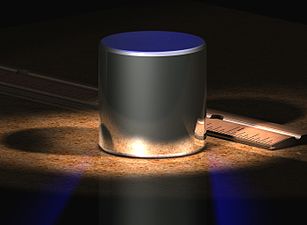User:Greg L/val failure example

Though not offering a practical realization, this definition would precisely define the magnitude of the kilogram in terms of a certain number of carbon‑12 atoms. Carbon‑12 (12C) is an isotope of carbon. The mole is currently defined as “the quantity of entities (elementary particles like atoms or molecules) equal to the number of atoms in 12 grams of carbon‑12.” Thus, the current definition of the mole requires that 1000⁄12 (83⅓) moles of 12C has a mass of precisely one kilogram. The number of atoms in a mole, a quantity known as the Avogadro constant, is experimentally determined, and the current best estimate of its value is 6.02214179(30)×1023 entities per mole (CODATA, 2006). This new definition of the kilogram proposes to fix the Avogadro constant at precisely 6.02214179×1023 with the kilogram being defined as “the mass equal to that of 1000⁄12 · 6.02214179×1023 atoms of 12C.”
The accuracy of the measured value of the Avogadro constant is currently limited by the uncertainty in the value of the Planck constant—a measure relating the energy of photons to their frequency. That relative standard uncertainty has been 50 parts per billion since 2006. By fixing the Avogadro constant, the practical effect of this proposal would be that the uncertainty in the mass of a 12C atom—and the magnitude of the kilogram—could be no better than the current 50 ppb uncertainty in the Planck constant. Under this proposal, the magnitude of the kilogram would be subject to future refinement as improved measurements of the value of the Planck constant become available; electronic realizations of the kilogram would be recalibrated as required. Conversely, an electronic definition of the kilogram (see Electronic approaches, below), which would precisely fix the Planck constant, would continue to allow 83⅓ moles of 12C to have a mass of precisely one kilogram but the number of atoms comprising a mole (the Avogadro constant) would continue to be subject to future refinement.
A variation on a 12C-based definition proposes to define the Avogadro constant as being precisely 84,446,8863 (≈6.022140985863258×1023) atoms. An imaginary realization of a 12-gram mass prototype would be a cube of 12C atoms measuring precisely 84,446,886 atoms across on a side. With this proposal, the kilogram would be defined as “the mass equal to 84,446,8863 × 83⅓ atoms of 12C.” The value 84,446,886 was chosen because it has a special property; its cube (the proposed new value for the Avogadro constant) is evenly divisible by twelve. Thus with this definition of the kilogram, there would be an integer number of atoms in one gram of 12C: 50,184,508,190,229,061,679,538 atoms.[1][Note 1]
Fortunately, definitions of the SI units are quite different from their practical realizations. For instance, the meter is defined as the distance light travels in a vacuum during a time interval of 1⁄299,792,458 of a second. However, the meter’s practical realization typically takes the form of a helium-neon laser, and the meter’s length is delineated—not defined—as 1579800.2987281500 wavelengths of light from this laser. Now suppose that the official measurement of the second was found to have drifted by a few parts per billion (it is actually exquisitely stable). There would be no automatic effect on the meter because the second—and thus the meter’s length—is abstracted via the laser comprising the meter’s practical realization. Scientists performing meter calibrations would simply continue to measure out the same number of laser wavelengths until an agreement was reached to do otherwise. The same is true with regard to the real-world dependency on the kilogram: if the mass of the IPK was found to have changed slightly, there would be no automatic effect upon the other units of measure because their practical realizations provide an insulating layer of abstraction. Any discrepancy would eventually have to be reconciled though because the virtue of the SI system is its precise mathematical and logical harmony amongst its units. If the IPK’s value were definitively proven to have changed, one solution would be to simply redefine the kilogram as being equal to the mass of the IPK plus an offset value, similarly to what is currently done with its replicas; e.g., “the kilogram is equal to the mass of the IPK + 42 ppb” (equivalent to 42 µg).
Notes[edit]
- ^ The uncertainty in the Avogadro constant narrowed since this proposal was first submitted to American Scientist for publication. The 2006 CODATA value for the Avogadro constant has a relative standard uncertainty of 50 parts per billion and the only cube root values within this uncertainty must fall within the range of 84,446,889.8 ±1.4; that is, there are only three integer cube roots (…89, …90, and …91) in this range and the value 84,446,886 falls outside of it. Unfortunately, none of the three integer values within the range possess the property of their cubes being divisible by twelve; one gram of 12C could not comprise an integer number of atoms. If the value 84,446,886 was adopted to define the kilogram, many other constants of nature and electrical units would have to be revised an average of about 0.13 part per million. The straightforward adjustment to this approach advanced by the group would instead define the kilogram as “the mass equal to 84,446,8903 × 83⅓ atoms of carbon‑12.” This proposed value for the Avogadro constant (≈6.02214184×1023) falls neatly within the 2006 CODATA value of 6.02214179(30)×1023) and the proposed definition of the kilogram produces an integer number of atoms in 12 grams of carbon‑12 (602,214,183,858,071,454,769,000 atoms), but not for 1 gram or 1 kilogram.
References[edit]
- ^ Georgia Tech, “ A Better Definition for the Kilogram?” 21 September 2007 (press release).
